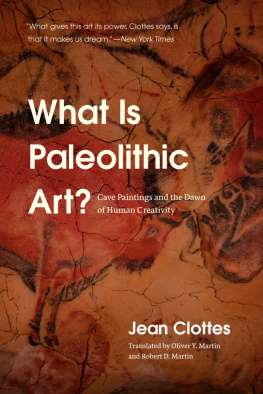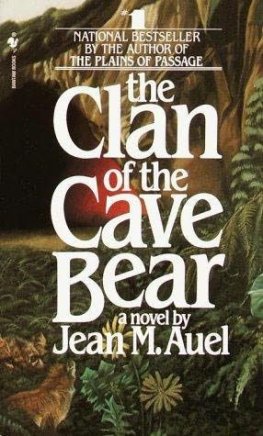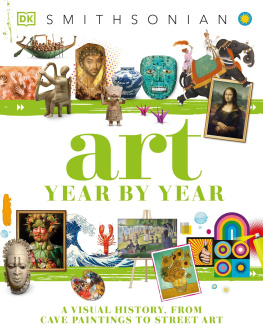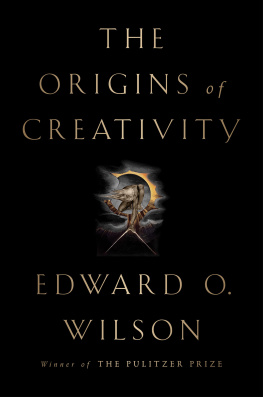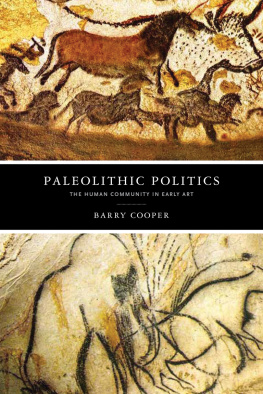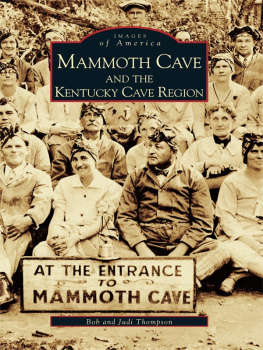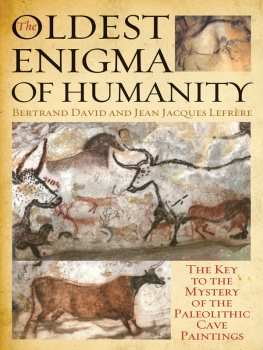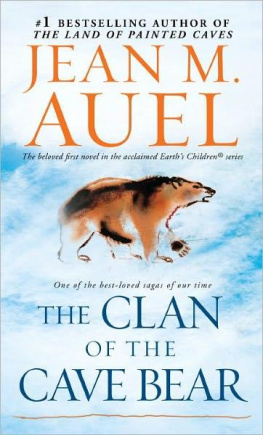Jean Clottes - What Is Paleolithic Art?: Cave Paintings and the Dawn of Human Creativity
Here you can read online Jean Clottes - What Is Paleolithic Art?: Cave Paintings and the Dawn of Human Creativity full text of the book (entire story) in english for free. Download pdf and epub, get meaning, cover and reviews about this ebook. year: 2016, publisher: The University of Chicago Press, genre: Art. Description of the work, (preface) as well as reviews are available. Best literature library LitArk.com created for fans of good reading and offers a wide selection of genres:
Romance novel
Science fiction
Adventure
Detective
Science
History
Home and family
Prose
Art
Politics
Computer
Non-fiction
Religion
Business
Children
Humor
Choose a favorite category and find really read worthwhile books. Enjoy immersion in the world of imagination, feel the emotions of the characters or learn something new for yourself, make an fascinating discovery.
- Book:What Is Paleolithic Art?: Cave Paintings and the Dawn of Human Creativity
- Author:
- Publisher:The University of Chicago Press
- Genre:
- Year:2016
- Rating:5 / 5
- Favourites:Add to favourites
- Your mark:
- 100
- 1
- 2
- 3
- 4
- 5
What Is Paleolithic Art?: Cave Paintings and the Dawn of Human Creativity: summary, description and annotation
We offer to read an annotation, description, summary or preface (depends on what the author of the book "What Is Paleolithic Art?: Cave Paintings and the Dawn of Human Creativity" wrote himself). If you haven't found the necessary information about the book — write in the comments, we will try to find it.
Jean Clottes: author's other books
Who wrote What Is Paleolithic Art?: Cave Paintings and the Dawn of Human Creativity? Find out the surname, the name of the author of the book and a list of all author's works by series.
What Is Paleolithic Art?: Cave Paintings and the Dawn of Human Creativity — read online for free the complete book (whole text) full work
Below is the text of the book, divided by pages. System saving the place of the last page read, allows you to conveniently read the book "What Is Paleolithic Art?: Cave Paintings and the Dawn of Human Creativity" online for free, without having to search again every time where you left off. Put a bookmark, and you can go to the page where you finished reading at any time.
Font size:
Interval:
Bookmark:

Jean Clottes
Translated by Oliver Y. Martin and Robert D. Martin
The University of Chicago Press | Chicago and London
Jean Clottes is a prominent French archaeologist and former general inspector for archaeology and scientific advisor for prehistoric art at the French Ministry of Culture. He is the author of Cave Art, among other books. Oliver Y. Martin is a lecturer in the Department of Environmental Systems Science at ETH Zurich, Switzerland. Robert D. Martin is curator emeritus in the Integrative Research Center at the Field Museum, Chicago.
The University of Chicago Press, Chicago 60637
The University of Chicago Press, Ltd., London
2016 by The University of Chicago
All rights reserved. Published 2016.
Printed in the United States of America
25 24 23 22 21 20 19 18 17 16 1 2 3 4 5
ISBN-13: 978-0-226-26663-3 (paper)
ISBN-13: 978-0-226-18806-5 (e-book)
DOI: 10.7208/chicago/9780226188065.001.0001
Originally appeared in French as Pourquoi lart prhistorique? Editions Gallimard, 2011.
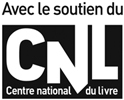
www.centrenationaldulivre.fr
Publication of this book has been aided by a grant from CNL.
Library of Congress Cataloging-in-Publication Data
Names: Clottes, Jean, author. | Martin, Oliver Y., 1973 translator. | Martin, R. D. (Robert D.), 1942 translator.
Title: What is paleolithic art? : cave paintings and the dawn of human creativity / Jean Clottes ; translated by Oliver Y. Martin and Robert D. Martin.
Other titles: Pourquoi lart prhistorique? English
Description: Chicago : The University of Chicago Press, 2016 | Includes bibliographical references and index.
Identifiers: LCCN 2015029149 | ISBN 9780226266633 (pbk. : alk. paper) | ISBN 9780226188065 (e-book)
Subjects: LCSH: Art, Prehistoric.
Classification: LCC N 5310 . C 58513 2016 | DDC 709/.012dc23 LC record available at http://lccn.loc.gov/2015029149
This paper meets the requirements of ANSI / NISO Z39.48-1992 (Permanence of Paper).
Ice Age people penetrated deep into vast caves to create images and engage in mysterious ceremonies, occasionally leaving traces on the walls and floors. They also adorned the walls of certain shelters where they lived with engravings, paintings, and sculptures that predominantly portrayed animals. In exceptional cases, engravings have been preserved on isolated rocks in the open (Fornols Haut, Pyrnes-Orientales) or along the banks of rivers (Foz Ca in Portugal; Siega Verde in Spain). It may seem something of a gamble to try to get close to the thought processes that guided these people. They are so remote from us, and they appear so alien because of this immense distance, that it is a seemingly futile exercise to investigate their motivations and, even more so, the significance of their images.
For quite some time, I also yielded to such skepticism, which is shared by most of my colleagues. The embarrassing question Why? is seemingly insoluble.
But surely all problems remain insoluble as long as nobody tackles them? Many specialists, undoubtedly the majority, are inclined to dodge the issue. Either they thrust it aside and never address it, or they focus on investigating the What? (describing and studying the themes represented, aiming to do so as thoroughly and as objectively as possible), the When? (addressing problems of dating and chronology), and the How? (meticulously studying the techniques employed). They may content themselves with rather brief explanations that admittedly always contain an element of truth: They represented and perpetuated their myths. But in extreme cases certain
For some fifteen years now, I have been particularly interested in the challenging problems of interpretation. There are three main reasons for this interest:
During a long research career essentially founded on archaeological excavations, predominantly in caves and shelters, I took a down-to-earth approach to Paleolithic lifestyles, if not to the underlying thought processes. I reached a point where I wished to know more about their beliefs and their worldviews as expressed in cave art, doubtless more informative in this respect than their tools and the evidence of their daily activities revealed by excavations. In the cave of Enlne (Montesquieu-Avants, Arige), I had encountered an extremely rich assemblage of Magdalenien portable art, consisting of engraved flat stones and engraved or sculptured bones or reindeer antlers, along with all kinds of body ornaments. Why did these objects accumulate to such an extent at this site? What thought processes drove their conception and production? The decorated caves in the Pyrenees, on which I worked for some considerable time (Rseau Clastres, Niaux), along with the Placard cave in Charente, the Cosquer cave in Marseille, and a number of others, had also aroused my unabated curiosity.
During those years, the vicissitudes of my career led me to travel a great deal, on every continent. In the course of my travels, guided and informed by my colleagues, I was able to visit a huge number of sites with rock art. These were and remain useful and even indispensable elements of comparison. Above all, I was able to engage in long discussions with research workers in the diverse countries that I visited and to read their publications in languages in which I am fluent (notably English and Spanish). Traditions connected with these artworks of the Holocene (that is to say, subsequent to the last Ice Age and hence relatively recent) have sometimes persisted. As far as the local populations are concerned, for example, Australian Aborigines or American Indians, they have occasionally preserved precious ancient knowledge; but, above all, they have perpetuated a state of mind, an attitude toward nature and the world in general, which differs from our own and extends back through the mists of time. In the course of my contacts and conversations with them, I have learned an enormous amountand unceasingly continue to do so. I have also gleaned valuable information from bibliographical research into their activities as recorded by missionaries, explorers, and ethnologists. Thanks to these influences, my reflections slowly matured.
The third element, and a decisive one, was my encounter with David Lewis-Williams and with his research. For many years, this South African prehistorian has studied the art, religion, and customs of the San people of southern Africa. He conceived the idea that Paleolithic art, like that of San artists, might have been created in the context of a shamanic form of religion. Together with his colleague Thomas Dowson, he published a seminal article that attracted a great deal of attention.
My reflections were fed by various inextricably connected sources. In the course of my travels, encounters with the descendants of those who had engraved or painted rock surfaces were incontestably the most rewarding moments of all. Nonetheless, regional specialists, my colleagues, who have engaged with themsometimes for many yearsrevealed to me unanticipated aspects of their modes of thought and of their art. They also provided me with precise information regarding ancient testimonies, often published in obscure treatises or articles. Every now and then, certain comments unexpectedly clarified a mystery regarding cave art that had intrigued me, remaining constantly at the back of my mind. I occasionally reported such insights in specialist articles. Above all, I drew upon them for my coursesI was able to witness the great interest shown by the public for such accounts and for their contribution to an improved understanding of Paleolithic parietal art.
Font size:
Interval:
Bookmark:
Similar books «What Is Paleolithic Art?: Cave Paintings and the Dawn of Human Creativity»
Look at similar books to What Is Paleolithic Art?: Cave Paintings and the Dawn of Human Creativity. We have selected literature similar in name and meaning in the hope of providing readers with more options to find new, interesting, not yet read works.
Discussion, reviews of the book What Is Paleolithic Art?: Cave Paintings and the Dawn of Human Creativity and just readers' own opinions. Leave your comments, write what you think about the work, its meaning or the main characters. Specify what exactly you liked and what you didn't like, and why you think so.

